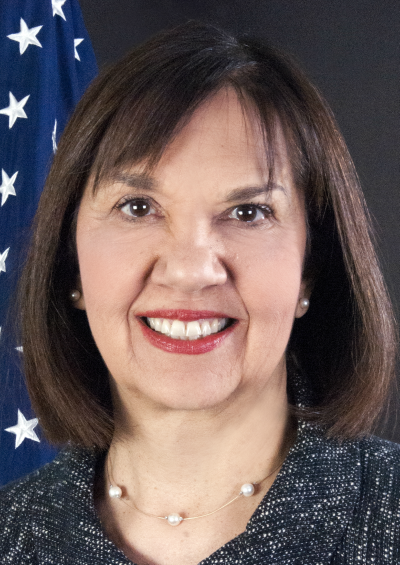
WASHINGTON—It would have been a big job if all the Federal Energy Regulatory Commission (FERC) had to do is play catch-up after nearly six months without a quorum. Now, the gas pipeline and electric power regulatory body also must deal with the impact of an appeals court ruling and an unusual U.S. Department of Energy (DOE) request that piled on top of that big workload.
 “Speaking for myself, I’m glad that we have a commission again, that I’m not the only one,” Commissioner Cheryl LaFleur told the North American Gas Forum Oct. 3. “I’m happy to have two new colleagues.”
“Speaking for myself, I’m glad that we have a commission again, that I’m not the only one,” Commissioner Cheryl LaFleur told the North American Gas Forum Oct. 3. “I’m happy to have two new colleagues.”
LaFleur was FERC’s sole member and acting chair until President Donald Trump’s nominees Neil Chatterjee and Robert Powelson were sworn in following Senate approval in August. The president also named Chatterjee as the board’s chairman.
The Trump administration has named two more FERC nominees, Richard Glick and Kevin McIntyre, that would bring the commission to its full, five-member strength. Both await Senate approval.
LaFleur credited FERC’s staff for doing what it could to ready issues for expedited review and action once a quorum returned. But reviews will still be methodical—despite the energy industry’s frequent wishes—since the commission has a mandate to hear all sides.
FERC has a responsibility to complete environmental and safety reviews as part of its regulatory process “and we are completely aware of that,” LaFleur added. “We are hearing more and more sophisticated arguments on environmental issues” and that increases the time it takes to complete each review. “We have to carefully consider the facts on a case-by-case basis.”
Furthermore, people often forget FERC has a continuing responsibility to review its actions once it grants action on a matter.
“When we vote out any request, we have a follow-up requirement to enforce them,” LaFleur emphasized.
Compounding its months-long backlog of work, the District of Columbia Circuit Court ruled in late August that FERC must consider greenhouse gas emissions from all of the gas-fired power plants that will be served by the Southeast Market Pipelines Project, including the 1.1 billion cubic feet per day (Bcf/d) Sabal Trail Transmission from Alabama to Florida. “That’s something we’re already doing,” LaFleur said, but the ruling likely will change—and slow—commission review procedures on new gas pipelines, she added.
Sabal Trail partners are Spectra Energy, NextEra Energy and Duke Energy. The ruling, in a case brought by the Sierra Club, has set back the expected service start by Sabal Trail, which is essentially complete.
Then Sept. 29, DOE Secretary Rick Perry asked FERC to consider an increase in rate compensation for power generators providing base load service from such fuels as coal and nuclear. In a letter, Perry asked the commission to “accurately price generation necessary to maintain reliability and resiliency.” The DOE’s Notice of Proposed Rule Making (NOPR) would ideally provide for “recovery of costs of fuel-secure generation units frequently relied upon to make our grid reliable and resilient.” Adding to the unusual nature of receiving an NOPR request directly from the department, Perry also called for an expedited, fast-track, 60-day review period.
That letter rated a “Face palm of the day: Leave it to the Trump administration to unite oil and solar trade groups against him,” by Ethan Bellamy, senior analyst for Baird Energy Research, in an Oct. 2 research report. At least a dozen trade associations, including such strange bedfellows as the American Petroleum Institute and Solar Energy Industries Association, protested the NOPR.
FERC does not have to approve the DOE request but must consider it, LaFleur said. The 60-day time frame will be very difficult to achieve, she noted, since it will trigger hundreds, if not thousands, of official comments. All must be reviewed by the commission.
The commission has its critics but it does a good job of reviewing projects before it issues a project certificate, mindful that its actions can, and often are, reviewed in court, the commissioner said.
“I am an unapologetic supporter of competitive markets,” LaFleur concluded. She has seen improving technology vastly increase the nation’s reserves of gas since she entered the regulatory arena in the 1990s “and we have seen prices drop, which is exactly the way markets should work.”
Paul Hart can be reached at pdhart@hartenergy.com.
Recommended Reading
EOG Ramps Gassy Dorado, Oily Utica, Slows Delaware, Eagle Ford D&C
2025-03-16 - EOG Resources will scale back on Delaware Basin and Eagle Ford drilling and completions in 2025.
US Oil, Gas Rig Count Unchanged This Week
2025-03-14 - The oil and gas rig count was steady at 592 in the week to March 14. Baker Hughes said that puts the total rig count down 37, or about 6% below this time last year.
Oxy CEO: US Oil Production Likely to Peak Within Five Years
2025-03-11 - U.S. oil production will likely peak within the next five years or so, Oxy’s CEO Vicki Hollub said. But secondary and tertiary recovery methods, such as CO2 floods, could sustain U.S. output.
Expand Lands 5.6-Miler in Appalachia in Five Days With One Bit Run
2025-03-11 - Expand Energy reported its Shannon Fields OHI #3H in northern West Virginia was drilled with just one bit run in some 30,000 ft.
Trump Says He Will Double Tariffs on Canadian Metals to 50%
2025-03-11 - President Trump said he would double his tariffs on Canadian steel and aluminum products in response to Ontario placing a 25% tariff on electricity supplied to the U.S.
Comments
Add new comment
This conversation is moderated according to Hart Energy community rules. Please read the rules before joining the discussion. If you’re experiencing any technical problems, please contact our customer care team.



